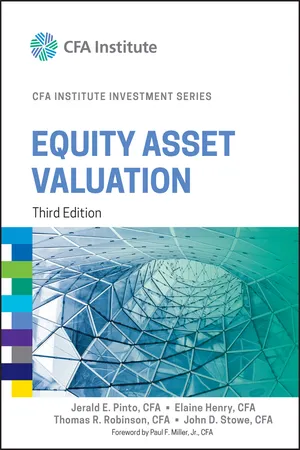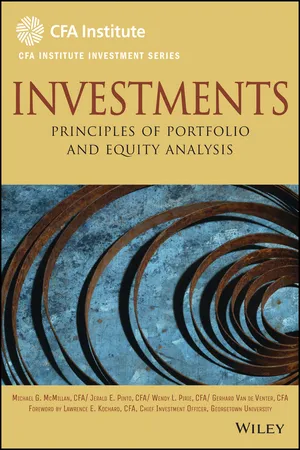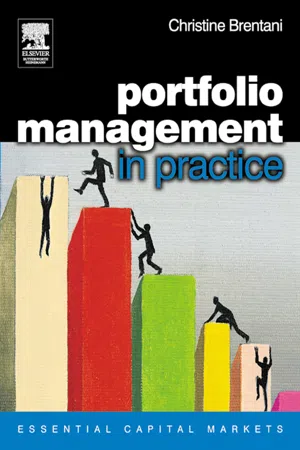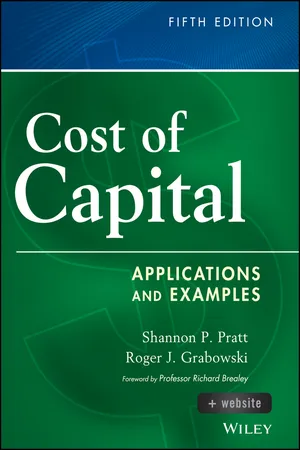Economics
Gordon Growth Model
The Gordon Growth Model is a method used to value a stock by estimating its future dividends. It assumes that dividends will grow at a constant rate indefinitely. The model calculates the present value of all future dividends to determine the stock's intrinsic value.
Written by Perlego with AI-assistance
Related key terms
1 of 5
8 Key excerpts on "Gordon Growth Model"
- eBook - ePub
- Jerald E. Pinto, Elaine Henry, Thomas R. Robinson, John D. Stowe(Authors)
- 2015(Publication Date)
- Wiley(Publisher)
Equation 7 ), leads to a simple and elegant valuation formula that has been influential in investment practice. This section explores the development of the Gordon Growth Model and illustrates its uses.4.1. The Gordon Growth Model Equation
The simplest pattern that can be assumed in forecasting future dividends is growth at a constant rate. In mathematical terms, this assumption can be stated aswhere g is the expected constant growth rate in dividends and Dtis the expected dividend payable at time t. Suppose, for example, that the most recent dividend, D0 , was €10. Then, if a 5 percent dividend growth rate is forecast, the expected dividend at t = 1 is D1 = D0 (1 + g) = €10 × 1.05 = €10.5. For any time t, Dtalso equals the t = 0 dividend, compounded at g for t periods:(8)To continue the example, at the end of five years the expected dividend is D5 = D0 (1 + g)5 = €10 × (1.05)5 = €10 × 1.276282 = €12.76. If D0 (1 + g)tis substituted into Equation 7 for Dt, it gives the Gordon Growth Model. If all of the terms are written out, they are(9)Equation 9 is a geometric series; that is, each term in the expression is equal to the previous term times a constant, which in this case is (1 + g)/(1 + r). This equation can be simplified algebraically into a much more compact equation:16(10)Both equations are equivalent because D1 = D0 (1 + g). In Equation 10 , it must be specified that the required return on equity must be greater than the expected growth rate: r > g. If r = g or r < g, Equation 10 as a compact formula for value assuming constant growth is not valid. If r = g, dividends grow at the same rate at which they are discounted, so the value of the stock (as the undiscounted sum of all expected future dividends) is infinite. If r < g, dividends grow faster than they are discounted, so the value of the stock is infinite. Of course, infinite values do not make economic sense; so constant growth with r = g or r < g does not make sense.To illustrate the calculation, suppose that an annual dividend of €5 has just been paid (D 0 = €5). The expected long-term growth rate is 5 percent, and the required return on equity is 8 percent. The Gordon Growth Model value per share is D0 (1 + g)/(r − g) = (€5 × 1.05)/(0.08 − 0.05) = €5.25/0.03 = €175. When calculating the model value, be careful to use D1 and not D0 - eBook - PDF
- Scott Besley, Eugene Brigham, Scott Besley(Authors)
- 2021(Publication Date)
- Cengage Learning EMEA(Publisher)
P / 0 5 D 0 s1 1 gd 1 s1 1 r s d 1 1 D 0 s1 1 gd 2 s1 1 r s d 2 1 Á 1 D 0 s1 1 gd ` s1 1 r s d ` 5 D 0 s1 1 gd r s 2 g 5 D / 1 r s 2 g 5 value of a constant growth stock Equation 7.2 3 The second line in Equation 7.2 is derived by applying the algebra of geometric progressions. 4 The constant growth model as set forth in the second line of Equation 7.2 is often called the Gordon model, after Myron J. Gordon, who did much to develop and popularize it. 155 CHAPTER 7: Stocks (Equity)—Characteristics and Valuation Copyright 2022 Cengage Learning. All Rights Reserved. May not be copied, scanned, or duplicated, in whole or in part. Due to electronic rights, some third party content may be suppressed from the eBook and/or eChapter(s). Editorial review has deemed that any suppressed content does not materially affect the overall learning experience. Cengage Learning reserves the right to remove additional content at any time if subsequent rights restrictions require it. Inserting values from our illustrative stock, we find that when investors require a 20 percent return, the value of the stock should be $11.20: P / 0 5 $1.60s1.05d 0.20 2 0.05 5 $1.68 0.15 5 $11.20 Figure 7.1 illustrates the concept underlying the valua- tion process for this constant growth stock. Dividends are growing at the rate g 5 5%. Because r s . g, however, the present value of each future dividend is declining. For example, the dividend in Year 1 is D / 1 5 D 0 (1 1 g) 1 5 $1.60(1.05) 5 $1.68. The present value of this dividend, discounted at 20 percent, is PV(D / 1 ) 5 $1.68/(1.20) 1 5 $1.40. The dividend expected in Year 2 grows to D / 2 5 $1.68(1.05) 5 $1.764, but the present value of this divi- dend falls to PV(D / 2 ) 5 $1.225. Continuing, D / 3 5 $1.8522 and PV(D / 3 ) 5 1.0719, and so on. - eBook - ePub
Investments
Principles of Portfolio and Equity Analysis
- Michael McMillan, Jerald E. Pinto, Wendy L. Pirie, Gerhard Van de Venter(Authors)
- 2011(Publication Date)
- Wiley(Publisher)
An analyst might be dissatisfied with these assumptions for many reasons. The equities being examined might not currently pay a dividend. The Gordon assumptions might be too simplistic to reflect the characteristics of the companies being evaluated. Some alternatives to using the Gordon model are as follows:- Use a more robust DDM that allows for varying patterns of growth.
- Use a cash flow measure other than dividends for valuation purposes.
- Use some other approach (such as a multiplier method) to valuation.
Applying a DDM is difficult if the company being analyzed is not currently paying a dividend. A company may not be paying a dividend if (1) the investment opportunities the company has are all so attractive that the retention and reinvestment of funds is preferable, from a return perspective, to the distribution of a dividend to shareholders or (2) the company is in such shaky financial condition that it cannot afford to pay a dividend. An analyst might still use a DDM to value such companies by assuming that dividends will begin at some future point in time. The analyst might further assume that constant growth occurs after that date and use the Gordon Growth Model for valuation. Extrapolating from no current dividend, however, generally yields highly uncertain forecasts. Analysts typically choose to use one or more of the alternatives instead of or as a supplement to the Gordon Growth Model.EXAMPLE 10-7 Gordon Growth Model in the Case of No Current DividendA company does not currently pay a dividend but is expected to begin to do so in five years (at t = 5). The first dividend is expected to be $4.00 and to be received five years from today. That dividend is expected to grow at 6 percent into perpetuity. The required return is 10 percent. What is the estimated current intrinsic value?Solution: The analyst can value the share in two pieces:1. The analyst uses the Gordon Growth Model to estimate the value at t = 5; in the model, the year-ahead dividend is $4(1.06). Then the analyst finds the present value of this value as of t - eBook - PDF
Understanding Financial Management
A Practical Guide
- H. Kent Baker, Gary Powell(Authors)
- 2009(Publication Date)
- Wiley-Blackwell(Publisher)
• As the difference between k s and g widens, the stock value falls. • As the difference between k s and g narrows, the stock value rises. • Small changes in the difference between k s and g can lead to large changes in the stock’s value. Variable growth A company may experience different levels of growth in earnings and dividends over time. A variable growth valuation model is a valuation approach that allows for a change in the dividend growth rate. That is, different growth rates occur during specific segments of the overall holding period. Thus, a characteristic of such a model is a multi-stage growth pattern . For example, a two-stage valuation model might involve a high growth period 148 THE FOUNDATION followed by a stable or “steady state” growth period. Because a company cannot maintain high growth forever, it is likely to return to a more sustainable rate of growth at some time in the future. The model is suitable for companies that cannot sustain high dividend pay-ments. Limitations of such a model include the practical difficulty of defining the length of the high growth period and the abrupt drop to stable growth. To reduce these limitations, other models depend on different assumptions. For example, a three-stage valuation model can allow for an initial period of high growth, a transitional period where dividend growth has declined to more moderate growth, and a final stable-growth stage. Such a model could be appropriate for valuing firms with very high current growth rates. One type of two-stage model is the temporary supernormal growth valuation model . As Equation 5.22 shows, the temporary supernormal growth DDM states that the value of a firm’s common stock equals the present value of the expected dividends during the above-normal growth period plus the present value of the terminal price, which is the value of all remaining dividends to infinity starting at the beginning of the constant growth. - eBook - PDF
- Christine Brentani(Author)
- 2003(Publication Date)
- Butterworth-Heinemann(Publisher)
For companies experiencing varied growth rates, the two-stage dividend growth model is utilized. To determine the proper value of the stock, dividends must be discounted by the applicable growth rate for the specified periods. The company will have one growth rate for one period and another growth rate after that. The two-stage dividend growth model (also known as the multi-stage dividend discount model) can be written as follows: V 0 = D 0 (1 + g 1 ) (1 + k) + D 1 (1 + g 2 ) (1 + k) 2 + D(2) (1 + g 2 ) (k – g 2 (1 + k) 2 where: V 0 = value of the stock D 1 = next period’s estimated dividend based on the company’s growth rate in dividends k = required rate of return or discount rate g 1 = company’s growth rate in stage 1 g 2 = company’s growth rate in stage 2. For example, Company C pays an annual divided of $1.00 and has a dividend growth rate of 10% per annum. Assuming the growth rate in dividends is expected to drop to 6% per starting in year 3 and the required rate of return on the stock is 7%, calculate the value of the stock using the two-stage dividend growth model. At the end of year 2, the company’s following year growth rate becomes 8% and D 1 = ($1.00 × 1.10) = $1.10 D 2 = ($1.10 × 1.10) = $1.21 D 3 = ($1.21 × 1.06*) = $1.28 * At the end of year 2, next year’s growth rate becomes 6% and D 3 = D 2 × 1.06. 135 Portfolio Management in Practice Using the formula, the value of the company’s stock is: V 0 = $1.10 1.07 + $1.21 (1.07) 2 + $1.28 (0.07 – 0.06) (1.07) 2 = $1.03 + $1.06 + $128 (1.07) 2 = $1.03 + $1.06 + $111.80 = $113.89 The longer the number of years that a firm can enjoy extraordinary profits, the bigger the expected jump in the stock price due to the availability of these profitable projects. - John W. Kensinger(Author)
- 2015(Publication Date)
- Emerald Group Publishing Limited(Publisher)
Thus, dividends growth rates determine the expected external financing required for new investments. As far as dividend payout is a distribution of an income, the literature of finance includes two competing models: earnings and free cash flow models. In the United States, the fact that the capital gains tax is less than personal income tax induces investors with high tax brackets to sup-port retaining corporate earnings which create an accumulated source of 106 TAREK ELDOMIATY ET AL. internal financing. In this case, the competition between the earnings and cash flow models is apparent. If the company has growing investment opportunities, the free cash flow model outperforms the earnings model when explaining changes in dividend growth rates. Otherwise, if the com-pany does not have any exploitable investment opportunities, the company as well as shareholders may favor dividends payout. The earnings model is a synonym of the income statement and balance sheet equations. Their premises conclude that less payout means an accu-mulated internal financing (retained earnings) that can be used to meet the investment requirements. Nevertheless, internal financing may or may not be associated with new investments. This is the direct reason that the free cash flow model is offered in order to take the investment decisions into consideration ( Bodenhorn, 1984 ; Lee, 1982 ). Therefore, according to the financial theory, firms’ investment behavior can be traced using dividend growth rates. Related studies in the literature offer earnings and free cash flow as two competing models that show how much distributable earnings are left to shareholders ( Yoon, 2005 ). In the earnings model, the dividend growth rates are discretionary, while in the free cash flow model, the dividend growth rates are stochastic. That is, no one knows the expected value of the investment precisely. It is clear that the resulted amount of dividend differs in each model.- eBook - ePub
Cost of Capital
Applications and Examples
- Shannon P. Pratt, Roger J. Grabowski(Authors)
- 2014(Publication Date)
- Wiley(Publisher)
A large number of companies do not pay dividends or pay only a token amount. In these cases, theoretically, the growth component, g, will be larger than that of an otherwise similar company that pays higher dividends. In practice, properly adjusting for this lack of dividends is extremely difficult. One way to avoid the dividend issue is to define cash flows more broadly. Instead of considering only the cash flows investors actually receive (dividends), the analyst might define net cash flows as those amounts that could be paid to equity investors without impeding a company's future growth. As noted in Chapter 3, net cash flow to equity, NCF e, is usually defined as in Formula 3.1. Of course, these cash flows are not those paid to investors, but, presumably, investors ultimately realize the benefit of these amounts through higher future dividends, a special dividend, or, more likely, stock price appreciation. Some analysts assume that over the very long run, net (after-tax) income should be quite close to cash flows. Therefore, they assume that net income can be used as a proxy for net cash flow. This assumption should be questioned on a case-by-case basis. For a growing company, capital expenditures and working capital requirements may make the assumed equivalence of net income and net cash flow so remote as to be irrelevant. The other, and perhaps more problematic, input is the expected growth rate. An important characteristic of the growth rate in the Gordon Growth Model is that it is the perpetual annual growth rate. Future growth rates do not have to be the same for every year; however, the average rate should be equal to this perpetual rate. For example, if a company is expected to grow at 10% per year for the next four years and 3% per year thereafter, then the average growth rate into perpetuity could be estimated as about 5% - Pablo Fernandez(Author)
- 2002(Publication Date)
- Academic Press(Publisher)
Chapter 6 Dividends and Market Value 121 In this case, the share's value is P 0 1 p q p u p d )g Ke p q p u p d )g DPS 0 When p q 0, this formula matches the geometric trinomial model without probability of bankruptcy. 6.9. THE SHARE'S VALUE WHEN THE DIVIDENDS HAVE TWO GROWTH RATES: THE TWO-STAGE GROWTH MODEL It is assumed that the DPS and the earnings per share EPS) grow at the rate g until year n and that after year n 1, they grow at the rate g n . Therefore, the dividend per share for year n is DPS n DPS 1 1 g) n 1 , and the dividend per share for year n 1 is DPS n 1 DPS 1 1 g) n 1 1 g n ) Growth of DPS g 0 n Year g n The share's price today is P 0 DPS 1 Ke g 1 1 g 1 Ke n DPS 1 1 g) n 1 1 g n ) Ke g n )1 Ke) n This expression reduces to: P 0 DPS 1 Ke g 1 1 g 1 Ke n 1 g g n Ke g n $ % One problem with this model is that the growth jump, which immediately goes from g to g n , rarely happens. A good approximation to this expression is obtained with the following formula: P 0 DPS 0 Ke g n [1 g n ) ng g n )] Appendix 6.6 shows the error made with this approximation. Q1 122 The Share's Value when the Dividends have Two Growth Rates 6.10. STOCK VALUATION WHEN DIVIDENDS HAVE TWO GROWTH RATES: MODEL H 10 It is assumed that the DPS grows at the initial rate g i in the W rst year. During 2H years, the growth rate gradually falls until it reaches the rate g n . From then onward, it grows every year at the rate g n . Growth of DPS g i 0 2H Year g n The share's value today can be approximated by: P 0 DPS 0 1 g n ) Ke g n DPS 0 Hg i g n ) Ke g n Appendix 6.7 shows the error made with this approximation. 6.11. STOCK VALUATION WITH THREE PERIODS OF DIVIDEND GROWTH It is assumed that the DPS grows at the initial rate g i for N1 years. From N1 to the year N2, the growth rate gradually falls until it reaches the rate g n . From then onward, it grows every year at the rate g n .
Index pages curate the most relevant extracts from our library of academic textbooks. They’ve been created using an in-house natural language model (NLM), each adding context and meaning to key research topics.







